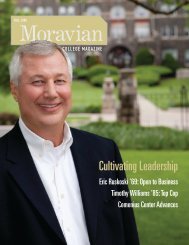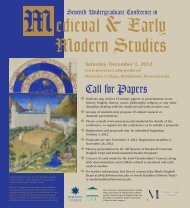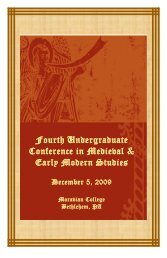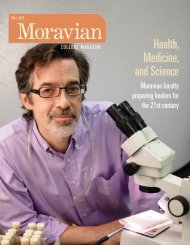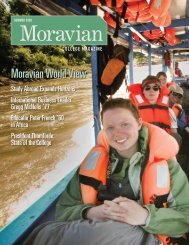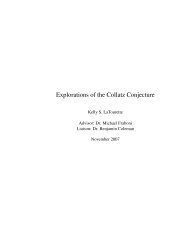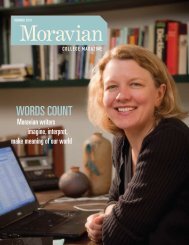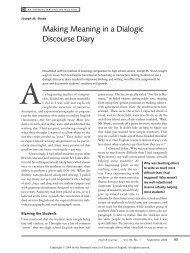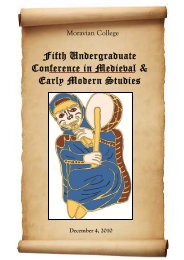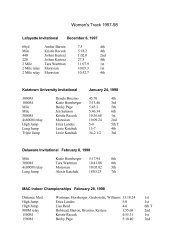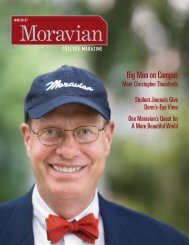MORAVIAN VISION - Moravian College
MORAVIAN VISION - Moravian College
MORAVIAN VISION - Moravian College
You also want an ePaper? Increase the reach of your titles
YUMPU automatically turns print PDFs into web optimized ePapers that Google loves.
<strong>Moravian</strong> Green<br />
><br />
<strong>Moravian</strong>’s Sustainability Task Force formed in<br />
2007, initiated by student Elyse Jurgen ’07 and<br />
developed by Chiu Cheng ’09, as a way to involve<br />
all campus constituencies in environmental<br />
initiatives. Last summer, President Thomforde<br />
tapped Professor Frank Kuserk to lead the group,<br />
ensuring continuity and momentum, while adding<br />
administrative support. “He advised me that<br />
sustainability is not just the task of one committee,<br />
but of everyone on campus,” said Frank. “To<br />
accomplish our objectives, faculty members, administrators,<br />
students, technology staff, facilities<br />
and support staff all must be involved.”<br />
At an October meeting, President Thomforde<br />
provided further direction—and challenges. “I’d<br />
in Hillside 6B, where students often open<br />
windows at night in winter, just to stay cool.<br />
Over the coming year, the class will monitor<br />
energy use in the residence, hoping the new<br />
thermostats make a difference.<br />
FMPC has also made strides toward<br />
sustainability. Energy Star ratings are an<br />
important criterion when purchasing new<br />
products, says Kim Sherr, FMPC project manager.<br />
(Energy Star products save money as<br />
they reduce greenhouse gas emissions.) The<br />
campus is ready and willing to compost yard<br />
and kitchen waste onsite, but until funds become<br />
available to purchase necessary equipment,<br />
leaves and branches will continue to<br />
go to municipal piles.<br />
Past obstacles to the greening of <strong>Moravian</strong><br />
now should be somewhat easier to<br />
overcome, however. Bolstered by President<br />
Thomforde’s signing of the Talloires Declaration<br />
on April 22, 2008, affirming <strong>Moravian</strong>’s<br />
commitment to sustainability, and a $40,000<br />
grant from the Soden family, sustainability<br />
at <strong>Moravian</strong> is gaining momentum. The new<br />
Campus Land Use and Facilities Master Plan,<br />
drafted in conjunction with the new strategic<br />
plan, commits the <strong>College</strong> to work toward<br />
sustainability concerning the environment,<br />
energy consumption, and building longevity.<br />
“It is absolutely crucial for the long-term<br />
health of <strong>Moravian</strong> <strong>College</strong> to be involved<br />
Beyond the Buzz: What It Means to Be Green<br />
like this committee to think about what our guiding<br />
principles should be—what is special or unique<br />
to the <strong>Moravian</strong> plan for sustainability?” President<br />
Thomforde asked. “Keep in mind that we are<br />
an educational institution, and that our college<br />
population changes each year, so our framework<br />
will guide those who follow us.”<br />
Dr. Thomforde challenged the group to<br />
create a list of guiding principles, assessment<br />
of its current status, five-year goals, and lines<br />
of accountability. The information—a strategic<br />
plan for sustainability, in essence—will help<br />
<strong>Moravian</strong> trustees determine how best to allocate<br />
resources for the greening of <strong>Moravian</strong> over the<br />
coming years.<br />
with these issues,” said President Thomforde<br />
at an October meeting of the Sustainability<br />
Task Force, a group representing faculty<br />
members, students, and staff. (See “Beyond<br />
the Buzz,” below.) At the meeting, he charged<br />
the group with establishing a list of guiding<br />
principles and goals to be used for carrying<br />
out green initiatives over the coming years.<br />
Possible goals identified by the task force<br />
include more organic, locally-grown foods;<br />
biodegradable utensils and dishware, as<br />
well as onsite composting; native landscaping<br />
that requires no supplemental water;<br />
public transportation vouchers for students,<br />
faculty, and staff; LEED-certified (Leadership<br />
in Energy and Environmental Design)<br />
building construction and renovation; and<br />
the inclusion of sustainability topics across<br />
all curricula. Within the next year or two,<br />
solar panels could be installed in the roof of<br />
Johnston Hall if grants materialize.<br />
The greening of <strong>Moravian</strong> <strong>College</strong> is no<br />
small task, to be sure. Achieving sustainability<br />
on campus will require the commitment<br />
and resources of every department and<br />
interest group, including alumni. But the<br />
impact can be enormous and far-reaching—<br />
sustaining not only the <strong>College</strong>, but also the<br />
earth beyond it. �<br />
16 <strong>MORAVIAN</strong> COLLEGE MAGAZINE FALL 2008<br />
PHOTO BY JOHN KISH IV



